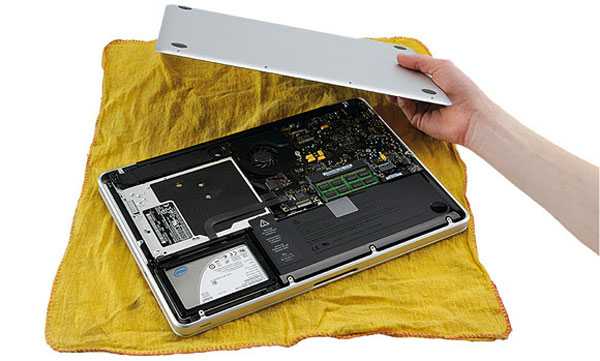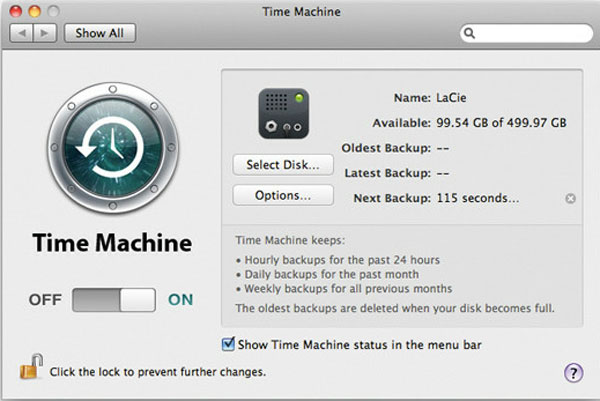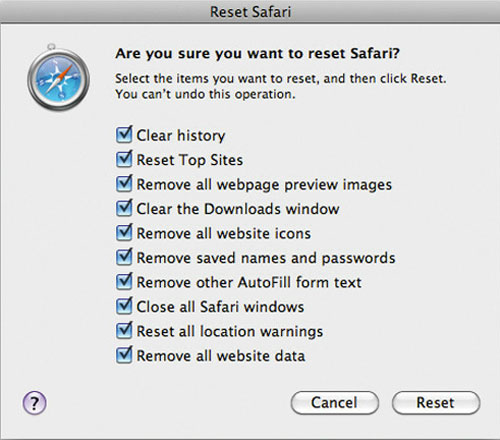Maximize your Mac
Mac computers can serve for years without problems, but you need to know how to keep your computer working. The following are measures to improve machine speed, both in hardware and software.
Some Macs after being used for at least 5 years may be slowed down or do not work well, and users may assume their machines are about to expire.
In fact, just by cleaning up your device's software and upgrading your hardware, you can almost bring new life to your device.
In some cases, the implementation is easier than you think and there is no need to dabble in the inside of the machine. Operations related to software modifications are still simple for most people.
Currently, there are still many 'apple' fans using Mac PowerPC models G4 and G5. Although limited because it is not possible to install a new version of Mac OS X operating system without using Intel chips, it is still available for web browsing, running office applications and for other tasks need lots of resources.
Because Apple still wants to support PowerPC users who can connect to iOS devices like the iPhone, iPad or iPod Touch, the latest iTunes version to sync the Mac with iOS devices will work on G4, provided you have installed OS X 10.5 operating system (although some features such as playing HD video cannot be used). It is important that this 5-year-old MacBook desktop is still able to do everything that ordinary users need to do.
The most common cause of slowing down old computer systems is that the hard drive is full and there is not enough RAM. But luckily, just add the maximum amount of memory that the machine can support is the problem solved. In addition, you need to upgrade to the new version of Mac OS X and replace the new high-speed hard disk drive (hard-drive drive) or even solid-state drive (SSD) if possible. financial capacity allowed.
And for all Macs, even the latest models, it is important to manage and clean the files so that the system works smoothly, and this job is not difficult for most users. . You just need to know that the music and image library can fill the hard drive, but you can move them to an external storage device. In addition, the browser's cache may be blocked after 1-2 years of use if you're not 'regular '.
Just pay attention to a little care and know the reason for slowing down, you may not have to sit in front of the monitor waiting for the machine to handle the job, and you can use the machine for a while longer.
RAM memory
For years, Apple has sold most Macs (especially popular Mac models) with less RAM than necessary. At that time, Macs were more expensive now and RAM for Macs was often more expensive than RAM for other computers. Apple is also well known for its ability to 'extort money' thanks to additional components and accessories.
Memory is probably the number one cause of slowdowns and poor performance. This situation is also common when the hard drive is full or damaged.
The Mac stores information in RAM when it is active, and if there is not enough space, the device uses the hard drive to make virtual memory. This makes the machine have a slow processing speed. Therefore, older Mac users often have to wait long while iPhoto handles images or the Safari browser loads web pages.
The mid-range or lower-end Mac has traditionally had 1GB of RAM, but that's just the minimum amount needed to run OS X 10.5 or 10.6. Each application you open needs more space to operate, and the more complex the application, the higher the memory capacity. In the future, memory requirements tend to increase, while OS X 10.7 now needs 2GB to operate.

Upgrading RAM and replacing storage drives will greatly improve Mac speed.
Fortunately, Apple allowed to upgrade the RAM of the Mac. The amount of RAM you can install depends on the model and MacBook notebooks usually have 2 RAM slots (MacBook Air line alone does not interfere with RAM). Older iMac desktops also have 2 slots, while most iBooks have 1 slot.
With the Mactracker app download from the App Store app store from MacTracker.ca, you can find your Mac model and know the number of available RAM slots in your device, and also the latest Mac OS X version. Whichever is supported. Desktops like G4, G5 and Mac Pro have more internal space so you can install more RAM bars, though sometimes you have to install each pair.
Since the number of slots on the motherboard is limited, you should install the highest capacity RAM that can be found, but with a desktop, you have the option of using a smaller capacity bar. If you like to mount RAM yourself, you only need less than 10 minutes. Instructions for your model can be found at www.apple.com/support.
HDD or SSD
Hard drives can be easily upgraded for laptop models (MacBook), MacBook desktops and even iMac and Mac mini. The old Mac had a small hard drive, especially for laptops, when the iTunes or iPhoto library took up all the space on the hard drive and slowed the machine because it had to try to find a place to write new data.
The hard drive is also slow because of wear and tear. When the hard drive in the computer starts to run noisily or makes strange noises, you have to really consider upgrading.
Note, the new purchased drive must be compatible with your Mac because the connection standard has changed over time. Large hard drives are now inexpensive and you can buy a 500GB drive for about 2 million dong. If possible, choose a model of 7200 rpm hard drive (rpm), which provides faster read and write data, accelerating the system.
Solid-state drives are usually fast and use less power, so it is suitable for laptops with higher prices than regular hard drives. If your MacBook is only used for web browsing and chatting more than for data storage, then the 64GB SSD is an excellent upgrade option.
Time Machine backup utility
If you're using Mac OS X 10.5, 10.6 or 10.7, you should remember to back up your device using the latest Time Machine utility. This also makes it easy to recover the old system when you need to replace the new hard drive, by loading the system DVD and then taking a step-by-step procedure to restore the data to the new drive.

Backing up with Time Machine will help you quickly recover data when needed.
If your Mac OS X version doesn't support Time Machine, use a 3rd-party backup tool like SuperDuper! or Carbon Copy Cloner to create a bootable backup before replacing the hard drive. Or you can copy all the data to an external hard drive, install the new system onto the new internal hard drive and copy everything. This will not be sure to copy all system data, but it will copy everything in your Home folder anyway.
Mac OS X operating system
Upgrading the operating system can also help speed up old Macs. So check with Mactracker to find the latest supported operating systems for your model. The last modified OS X version, Tiger (10.4), is the right choice for many older Macs, although some Mac models produced around 2004 can be upgraded to 10.5.8.
Mac OS X 10.6 Snow Leopard is the first version that only supports Intel processors, and version 10.7 requires an Intel 64-bit processor, except for early Intel Core models. However, the latest operating system version is not always the fastest if your hardware is old.
For example, version 10.5 Leopard runs slower on some models than 10.4 because it has more features but is heavily loaded because it has many common codes to work on Intel and PowerPC processors. At that time, your PowerPC Mac might be more beneficial if you still use version 10.4. Early Mac mini and MacBook models can support 10.7 but not enough to work well, in this case you should choose 10.6.
Even if your Mac is relatively new or has enough memory and fast hard drives, you may still experience slow performance and performance problems because of factors related to Other application software. These problems are not as serious as hardware problems, but over time they can increase and lead to consequences.
The image and music library is easy to fill up and take up all of the hard drive space. iPhoto and iTunes, and even iMovie if you use it, save all data on the primary drive partition, and that's the drive your system is running on. Copying CDs and transferring images from a camera or iPhone to a computer can also take up all of the hard drive space - a cause of slow machines.
If you need to see how large these libraries are, go to the Music and Pictures folders in the Home folder and open Get Info (Command + i) on the iTunes and iPhoto Library folders. If they are larger than 20 or 30GB and your hard drive is not very large, it's time to move these folders to another place.
You can use the manual method of dragging these folders to another partition or external hard drive. Or you can press the Option key at the same time you start 1 of 2 applications to have the option to create or boot from another library. This is a good way to maintain multiple libraries on external drives.
If you want to find out what takes up all the space on your computer, you can try WhatSize.
File management
File management is no longer a difficult job as before, since Apple introduced the Spotlight feature to help you find files quickly no matter where they are.
In order for the machine to work smoothly, it is important to organize the data neatly, avoid overlapping files and remove unnecessary data. Making it more tidy also makes backups smaller.
If there is little data, you should put them all in a folder. Time Machine will back up that folder even though the data inside that folder has been changed. So you should try to arrange things neatly from the beginning and everything will work well.
When you use a Mac, data is generated almost continuously. Your computer is also recording the process of using (log) and saving records to help it work better, increase the user experience. But there may be times when all this saved data actually starts to slow down the computer or cause software conflicts.

In Safari, select Reset Safari and then select the data to delete.
One of the main culprits is Safari or other browsers. All these browsers store a lot of information about your browsing habits. Sometimes this causes the machine to be confused when the old data is too much and cannot record new data. Please resolve this issue by resetting the browser. In Safari, select Reset Safari and then select the data to delete. In other browsers, this task can be called Clear Private Data.
Clear the cache
The same principle applies to Mac OS X. The operating system also records the usage and other data in the cache when the machine is operating. Over time, these data accumulate and every time the Mac starts or logs in, these data must be skimmed by the machine. This takes a lot of time and the more data, the longer the time.
Data in corrupted cache can also cause the machine to operate abnormally, or it may make the application inoperable. The best way to solve these problems is to use a free application like Titanium Software's OnyX. This application provides a shared window to delete chaotic files from the device. The software developer also offers a Maintenance application, which has many versions suitable for all operating systems from 10.2 onwards to 'maintain ' the computer system.
If you periodically use this OnyX software or similar software to delete log files, cache and other saved system data, you will have more disk space and speed up boot time. Log in to the machine and open the application.
Keep the device neat
Even with a computer with a clear purpose of use, if you run multiple applications at the same time, it will ' strain ' the machine's resources. If you open Photoshop, GarageBand and 10 tags on Safari on your MacBook at the same time, your device will obviously slow down.
When an application is opened, it uses RAM and a significant portion of the CPU's power depending on which application it is performing. If only running applications you are actually using, everything responds faster. This is especially true for older Macs with low-core processors, slow graphics cards and low memory. If you follow some or all of the above instructions, your old Mac will probably last longer.
 Ways to use the Eject button on the Macbook
Ways to use the Eject button on the Macbook Instructions on how to find the serial number of the Mac
Instructions on how to find the serial number of the Mac Upgrade MacBook with SSD
Upgrade MacBook with SSD Option keys on Mac that you don't know
Option keys on Mac that you don't know 6 methods to read Mac drives in Windows
6 methods to read Mac drives in Windows How to fix Read-only of external hard drive on Mac
How to fix Read-only of external hard drive on Mac